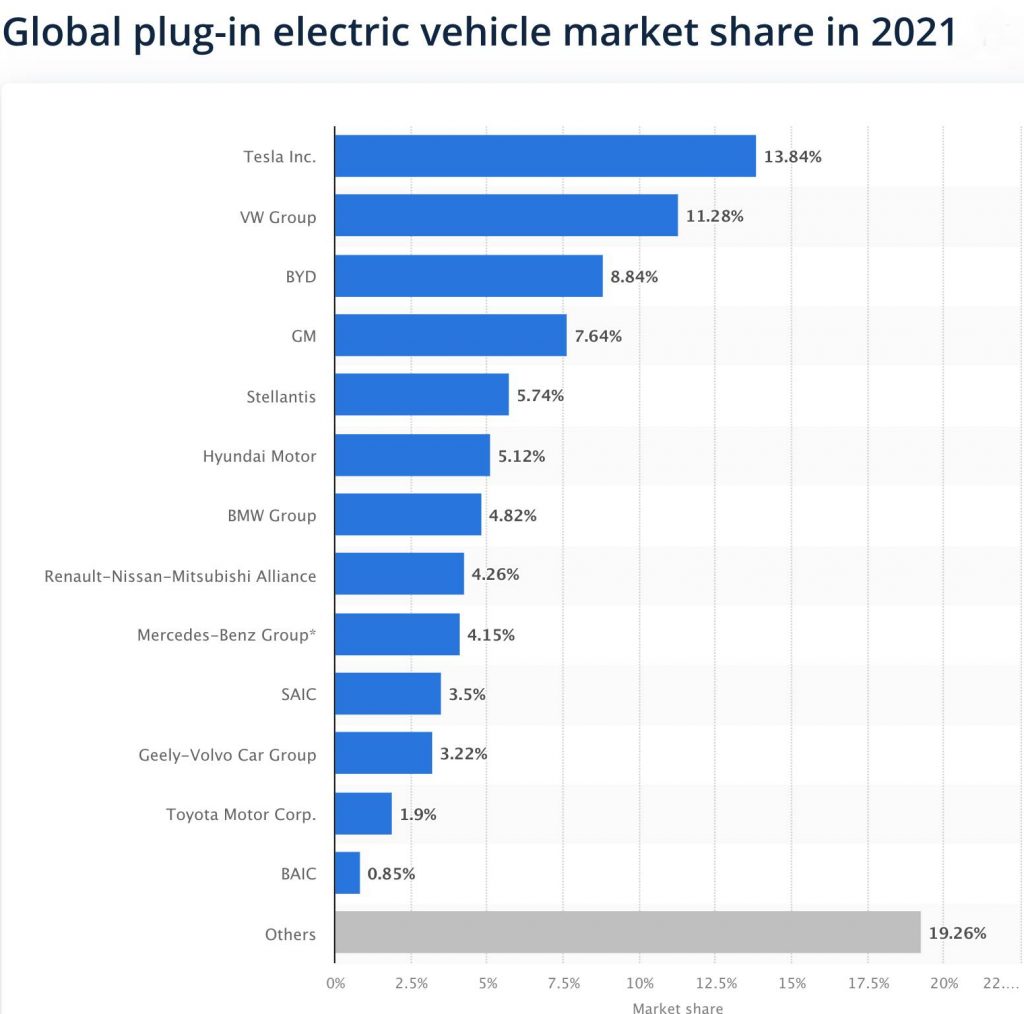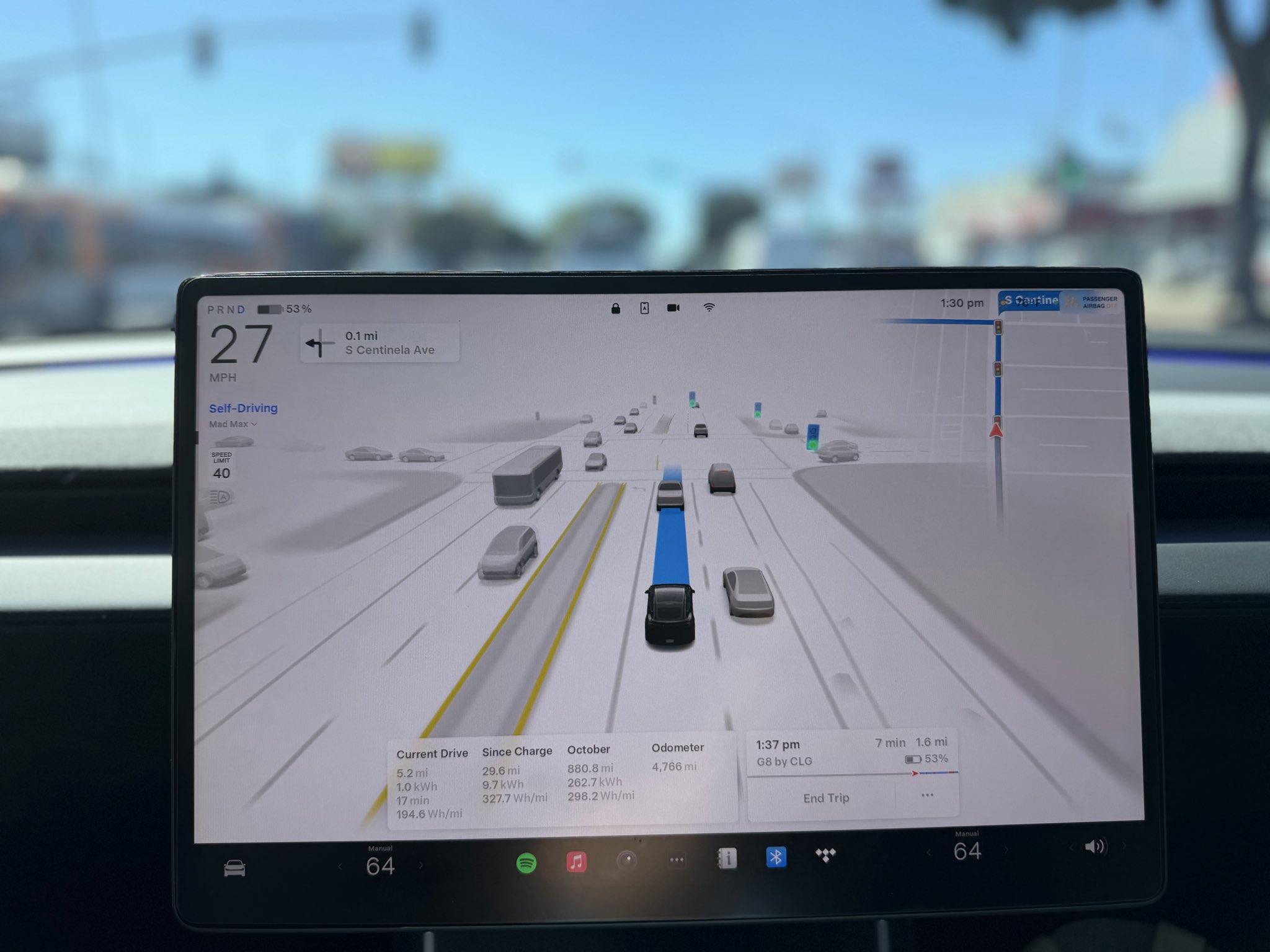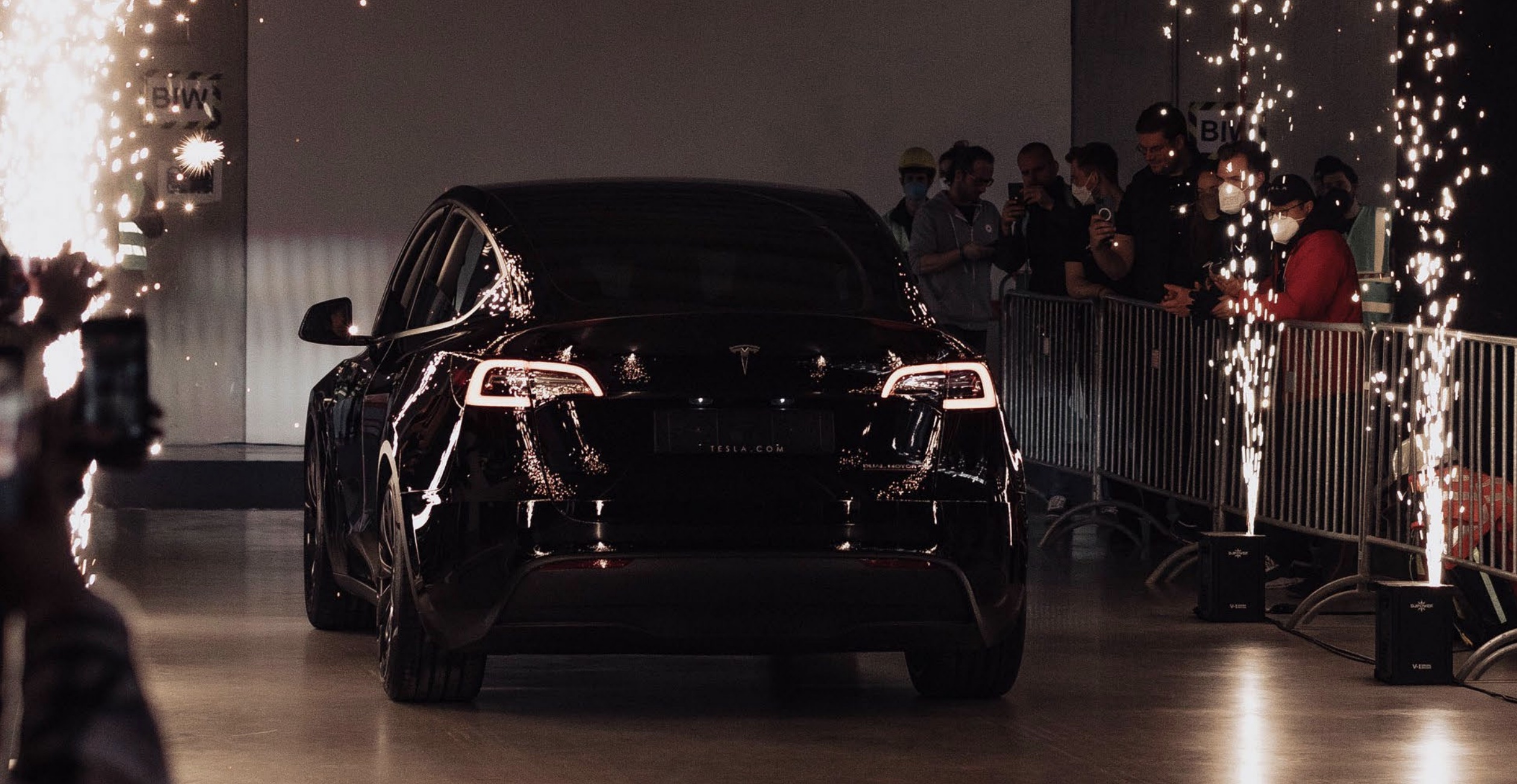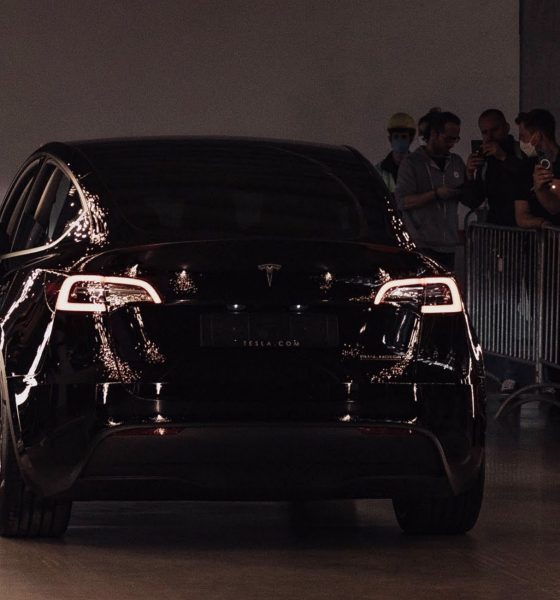According to Kelley Blue Book’s (KKB) data, Tesla dominated the United States electric vehicle market in the first quarter. Tesla vehicle sales accounted for 75% of all EVs sold between January and March 2022.
Tesla’s Model 3 and Model Y vehicles made up 68% of US EV market sales in Q1 2022. Based on those calculations, the Model S and Model X vehicles made up 7% of Tesla’s vehicle sales in the last quarter.
The Tesla Model Y came in first place as the best-selling EV in Q1 2022, followed by the Model 3 in second place and the Ford Mustang Mach-E in third place. The Model X and Model S also ranked in KKB’s Top 10 best-selling EVs in Q1 list at fourth and seventh place, respectively.
The significant gap between Model 3 and Ford Mustang Mach-E sales highlights Tesla’s dominance in the US EV market. Tesla sold 43,707 Model 3 units in the first quarter, while Ford sold 6,734 Mustang Mach-Es within the same time frame.
Tesla delivered 310,048 vehicles in the first quarter of 2022, setting another Q1 record. Its Q1 2022 results were somewhat hampered by Giga Shanghai shutdowns occurring at a crucial time in the quarter — towards the tail-end of the three-month period. Tesla also still dealt with ongoing supply chain challenges last quarter, similar to other automakers in the industry.
As per Automata Corp. figures, electric vehicle sales soared during the first quarter of this year. While EV sales gained traction, the overall auto industry reported a decline of 15.3% in new vehicles sales, hinting at a shift toward renewable energy vehicles.
As more automakers produce electric cars, the competition for Tesla is growing. For instance, the Hyundai Ioniq 5 is another notable car that made it on KBB’s recent list of best-selling EVs in the US for the first quarter. It came in fifth place on KBB’s list, right after the Model X and before the Tesla Model S. During the New York International Auto Show, the Hyundai Ioniq 5 won three awards, including World Car of the Year.

In the global EV market, Volkswagen closely followed Tesla’s market share in 2021. Statista calculated that Tesla was the best-selling EV manufacturer worldwide in 2021. Tesla sold 936,172 vehicles in total last year, making its global EV market share 13.84%. Volkswagen closely followed Tesla, claiming 11.28% market share.
As the competition grows in the EV market, Tesla will also have to expand. The Elon Musk-led company seems prepared to fight for its crown with help from its Gigafactories in Shanghai, Berlin, and the new HQ in Texas.
Tesla aims to produce up to 1.5 million vehicles in 2022. It also plans to start production on its other vehicles by 2023, including the Cybertruck, Semi, and Roadster.
The Teslarati team would appreciate hearing from you. If you have any tips, reach out to me at maria@teslarati.com or via Twitter @Writer_01001101.

News
Czech Deputy excited for Tesla FSD, hints at Transport Committee review
The ANO party lawmaker shared his thoughts about FSD in a post on social media platform X.

Martin Kolovratník, a Czech Republic Chamber of Deputies member, has expressed his excitement for Tesla’s Full Self-Driving (FSD) after an apparent constituent called for a quick approval for the advanced safety system.
The ANO party lawmaker, who drives both diesel and EV, shared his thoughts about the matter in a post on social media platform X.
The official’s initial statements
Kolovratník kicked off the exchange with a post outlining his coalition’s efforts to scrap highway toll exemptions for electric vehicles and plug-ins starting in 2027.
“Times have changed. Electric vehicles are no longer a fringe technology, but a full-fledged part of operations. And if someone uses the highway network, they should follow the same rules as everyone else. That’s the basis of fairness,” he wrote.
He emphasized equity over ideology, noting his personal mix of diesel and electric driving. “For this reason, there is no reason to continue favoring one technology at the expense of another… It’s not about ideology, it’s about equal conditions. That’s why we clearly agreed within the new coalition: the exemption for electric vehicles and plug-ins will end in 2027. The decision is predictable, understandable, and economically sound.”
Tesla FSD enthusiasm
The conversation pivoted to Tesla’s FSD when X user @robotinreallife, who seems to be one of the official’s constituents, replied that other matters are more important than ending highway exemptions for EVs.
“I’m happy to pay for the highway, but I have a question about a much more fundamental matter: The Netherlands will approve the operation of Tesla FSD in February 26, a technology that has been proven to reduce accidents. The Czech Republic has the option to immediately recognize this certification. Do you plan to support this step so that we don’t unnecessarily delay?” the X user asked.
Kolovratník responded promptly, sharing his own excitement for the upcoming rollout of FSD. “I know about it. I like it and it seems interesting to me. Once we set up the committees and subcommittees, we’ll open it right away in that transport one. Thanks for the tip, I’ll deliver the report,” the official noted in his reply on X.
Kolovratník’s nod to FSD hints at the system’s potentially smooth rollout to Czechia in the coming year. With the Netherlands possibly greenlighting FSD (Supervised) in early 2026, Kolovratník’s commitment could accelerate cross-border certification, boosting FSD’s foray into Europe by a notable margin.
News
Tesla Model 3 named New Zealand’s best passenger car of 2025
Tesla flipped the switch on Full Self-Driving (Supervised) in September, turning every Model 3 and Model Y into New Zealand’s most advanced production car overnight.

The refreshed Tesla Model 3 has won the DRIVEN Car Guide AA Insurance NZ Car of the Year 2025 award in the Passenger Car category, beating all traditional and electric rivals.
Judges praised the all-electric sedan’s driving dynamics, value-packed EV tech, and the game-changing addition of Full Self-Driving (Supervised) that went live in New Zealand this September.
Why the Model 3 clinched the crown
DRIVEN admitted they were late to the “Highland” party because the updated sedan arrived in New Zealand as a 2024 model, just before the new Model Y stole the headlines. Yet two things forced a re-evaluation this year.
First, experiencing the new Model Y reminded testers how many big upgrades originated in the Model 3, such as the smoother ride, quieter cabin, ventilated seats, rear touchscreen, and stalk-less minimalist interior. Second, and far more importantly, Tesla flipped the switch on Full Self-Driving (Supervised) in September, turning every Model 3 and Model Y into New Zealand’s most advanced production car overnight.
FSD changes everything for Kiwi buyers
The publication called the entry-level rear-wheel-drive version “good to drive and represents a lot of EV technology for the money,” but highlighted that FSD elevates it into another league. “Make no mistake, despite the ‘Supervised’ bit in the name that requires you to remain ready to take control, it’s autonomous and very capable in some surprisingly tricky scenarios,” the review stated.
At NZ$11,400, FSD is far from cheap, but Tesla also offers FSD (Supervised) on a $159 monthly subscription, making the tech accessible without the full upfront investment. That’s a game-changer, as it allows users to access the company’s most advanced system without forking over a huge amount of money.
News
Tesla starts rolling out FSD V14.2.1 to AI4 vehicles including Cybertruck
FSD V14.2.1 was released just about a week after the initial FSD V14.2 update was rolled out.

It appears that the Tesla AI team burned the midnight oil, allowing them to release FSD V14.2.1 on Thanksgiving. The update has been reported by Tesla owners with AI4 vehicles, as well as Cybertruck owners.
For the Tesla AI team, at least, it appears that work really does not stop.
FSD V14.2.1
Initial posts about FSD V14.2.1 were shared by Tesla owners on social media platform X. As per the Tesla owners, V14.2.1 appears to be a point update that’s designed to polish the features and capacities that have been available in FSD V14. A look at the release notes for FSD V14.2.1, however, shows that an extra line has been added.
“Camera visibility can lead to increased attention monitoring sensitivity.”
Whether this could lead to more drivers being alerted to pay attention to the roads more remains to be seen. This would likely become evident as soon as the first batch of videos from Tesla owners who received V14.21 start sharing their first drive impressions of the update. Despite the update being released on Thanksgiving, it would not be surprising if first impressions videos of FSD V14.2.1 are shared today, just the same.
Rapid FSD releases
What is rather interesting and impressive is the fact that FSD V14.2.1 was released just about a week after the initial FSD V14.2 update was rolled out. This bodes well for Tesla’s FSD users, especially since CEO Elon Musk has stated in the past that the V14.2 series will be for “widespread use.”
FSD V14 has so far received numerous positive reviews from Tesla owners, with numerous drivers noting that the system now drives better than most human drivers because it is cautious, confident, and considerate at the same time. The only question now, really, is if the V14.2 series does make it to the company’s wide FSD fleet, which is still populated by numerous HW3 vehicles.











